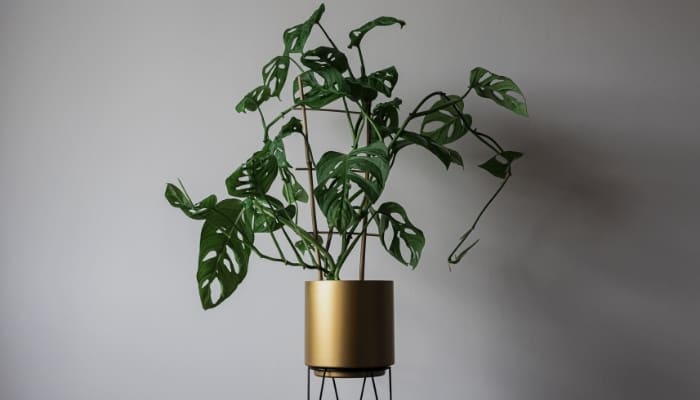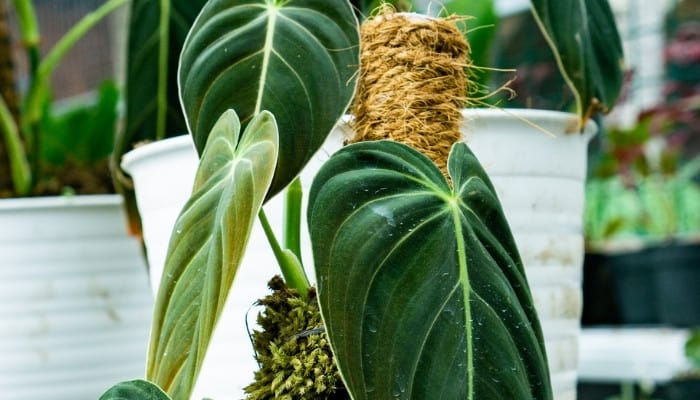When caring for indoor plants, moss is often utilized as a base for specific types such as orchids.
This moss can also be used to create a vertical growing surface for climbing plants in the form of a moss pole.
While most plants can survive without a moss pole to cling to, they are a beautiful and beneficial addition to a pot.
What is the purpose of a moss pole? Moss poles encourage vertical plant growth rather than horizontal growth. These are used by epiphytes, plants that use trees or rocks for support, to mimic their wild growing conditions. Moss poles can be purchased or fashioned from various upright supports wrapped in coco coir or similar material.
Houseplant enthusiasts can enter some aggressive debates on which plants should always have a moss pole versus which ones only need it for aesthetics.
By learning how to use a moss pole, which plants will benefit from a moss pole, and how to make your own, you can make the best decisions for your houseplants.
Moss Poles for Plants
The basics of a moss pole are pretty simple. It is a pole covered in moss. Since the moss holds moisture, aerial roots can secure themselves and use the pole as a source of water.
What Is a Moss Pole For?
Moss poles are upright structures that allow plants to climb and grow vertically. They mimic the wild environment of the forest, where climbing plants use trees for support and sustenance.
Why Use a Moss Pole?
By mimicking the wild environment of a climbing plant, you are allowing the plant to grow to its fullest potential.
Epiphytes that are grown on moss poles tend to produce more leaves that are larger and more beautiful.
Which Plants Need a Moss Pole?
Climbing plants that have aerial roots will benefit from having a moss pole to grow on. Many of these species can be successfully grown without a moss pole though.
Some plants with aerial roots for climbing include monstera, pothos, heartleaf philodendrons, creeping figs, and jasmine.
Which Size Moss Pole Do I Need?
The size of the moss pole that you need will depend on the current size of your plant and/or the estimated largest size of your plant.
Ideally, you will give your plant a moss pole that is 6-12 inches taller than its current size. If your plant has reached full size, the moss pole should be equal in height.
How To Make a Moss Pole
It is very simple to make a moss pole. All you need is something to use as your pole (PVC or wooden dowels work well), a string to attach the moss, and soaked sphagnum moss.
Once the moss has absorbed water, layer it on the pole, and secure it with the string.
What Moss Is Best for a Moss Pole?
Sphagnum moss is the best (and only) moss to use for moss poles. It has a large structure, and it holds moisture well.
How To Use a Moss Pole
Place the moss pole in the center or back third of your pot. Gently secure the stems of the plant around the moss pole so the aerial roots have the opportunity to grow into the pole.
How To Secure a Plant to a Moss Pole
Use string or fishing line to gently secure plant stems against the moss pole. Do not tighten the string more than necessary because the plant will still need to grow.
If your plant already has aerial roots, do your best to tuck the aerial roots into the moss. If your plant has aerial root buds, make sure they are facing inward toward the moss.
Once the roots have securely grown into the moss pole, you can choose to remove the string, but it is not necessary.
How To Train a Plant To Climb Moss Pole
It is best to start with a young plant when you are trying to train it to climb a moss pole. Use string or fishing line to gently secure the stems to the pole.
Make sure that the aerial roots are facing into the moss. Keep the moss moist. This will encourage new aerial roots to grow toward and into the moss pole.
How To Keep Moss Pole Moist
The easiest option for keeping the sphagnum moss on the pole moist is to mist it daily.
If you live in a dry environment or if your plant is a heavy drinker, you may need to slowly pour water directly onto the pole to allow the moss to hydrate.
If you do not want to worry about hydrating the moss every day, look into self-watering moss poles. These poles use a central reservoir of water and a wick to maintain hydrated moss.
They are easy to make yourself, as you can see below.
How Long Does a Moss Pole Last?
Moss poles typically last between 4 and 6 years. The lifespan will depend on the materials used.
A wooden dowel will eventually degrade due to the constant moisture, but a plastic dowel or PVC will hold up longer.
Moss Pole DIY
Moss poles are easy and cheap to make yourself. All you need is a pole (can be a wooden dowel, metal pole, or PVC), string or fishing wire, sphagnum moss, and water.
Before you begin, soak the sphagnum moss in water for 15-20 minutes. It will expand quite a bit. Once it is hydrated, gently squeeze out any excess water.
Layer the moist moss around your center pole using the string. This is best done in multiple layers with multiple pieces of string.
Leave the bottom 6-12 inches bare since this portion will be in the soil.
What To Do When a Plant Outgrows Moss Pole?
It is best to avoid removing aerial roots from a moss pole, so your best option is to add onto the moss pole or add an additional pole.
You can use string or fishing wire to attach an additional length of moss pole to the top. Some moss poles have a design that allows you to easily stack them together for your desired height.
Your last option is to add a new, taller moss pole directly next to the existing pole. This will allow the existing aerial roots to remain undisturbed while the new growth has a place to attach.
Can You Replace a Moss Pole?
It can be difficult to replace a moss pole because the plant has most likely put down aerial roots throughout the length of the pole.
Removing the aerial roots can damage the plant. If you must remove and replace the moss pole, do so gently, and try to save as many aerial roots as possible.
A better option would be to add a new moss pole directly next to the old one. This will allow new aerial roots to secure themselves to the new pole and support the plant.
Can a Moss Pole Die?
Moss poles do not die but they can (and will) decay over time.
Since many of the materials used are natural, they will slowly break down due to the constant moisture and the plant absorbing nutrients.
Self-Watering Moss Pole
Self-watering moss poles have a central reservoir and a wick that wraps around the pole under the moss. The central reservoir is filled with water that is slowly transferred to the moss via the wick.
Water will only need to be added as necessary, and the pole should remain hydrated for extended periods.
Can I Use Peat Moss for Moss Pole?
Peat moss will not work for moss poles. The fibers are too small to be secured to the pole.
Do Alocasia Need a Moss Pole?
Alocasia are self-supporting plants and do not need a moss pole. They do not have the aerial roots necessary for the plant to secure itself to the pole.
However, if the plant tends to lean to one side or is unable to keep larger leaves upright, you could secure it to a moss pole for support if you like.
Will Pothos Climb a Moss Pole?
Pothos plants are excellent at climbing moss poles. They are easy to care for, grow quickly, and have aerial roots to climb the pole.
Does Monstera Need a Moss Pole?

Monstera plants can grow without a moss pole, but most varieties will benefit from having one. Oftentimes, monsteras grown on moss poles produce larger and more beautiful foliage.
When To Use a Moss Pole for Monstera
Young monsteras don’t need a moss pole because the leaves are small and light. A good time to add a moss pole for your monstera is the first time you repot it.
As the plant grows larger, it will benefit from the extra support.
What Size Moss Pole for Swiss Cheese Plant
The size of your moss pole will depend on the size of your swiss cheese plant. Choose a pole that is 6-12 inches taller than your plant.
Repotting Monstera With Moss Pole
Ideally, your monstera plant will be securely attached to the moss pole thanks to its aerial roots. Therefore, you can just repot your monstera as normal and move the moss pole along with the plant.
If your plant is outgrowing the moss pole, add additional length to the top or add a second, taller pole next to the existing one.
How To Attach Monstera To a Moss Pole
Use string, twine, or fishing line to gently attach the monstera stems to the moss pole. Make sure that the aerial roots or root buds are facing the wet moss.
Does a Rubber Plant Need a Moss Pole?
Rubber plants do not need a moss pole because they do not have aerial roots to attach to the pole.
Rubber trees can have issues falling over as they grow, so they do benefit from supportive staking.
Does a Split-Leaf Philodendron Need a Moss Pole?
A split-leaf philodendron can grow without a moss pole, but it will greatly benefit from one. In addition to mimicking the wild environment, it adds a beautiful touch to the home.
Coir Pole vs. Moss Pole
Coir is made from shredded coconut husks. It can be purchased in sheets that are wrapped around poles. Coir does not hold moisture the same way that sphagnum moss does.
While coir poles make great support structures, moss structures are better for aerial root attachment.
Where Can I Buy a Moss Pole?
Amazon is a great source for moss poles and other houseplant accessories thanks to their competitive prices, extensive variety, and fast shipping.
Do I Need a Moss Pole?
If you have a climbing plant, it will benefit from a moss pole. Not only does it help the plant follow its natural growth pattern, but your home gets a beautiful, vertical addition.

